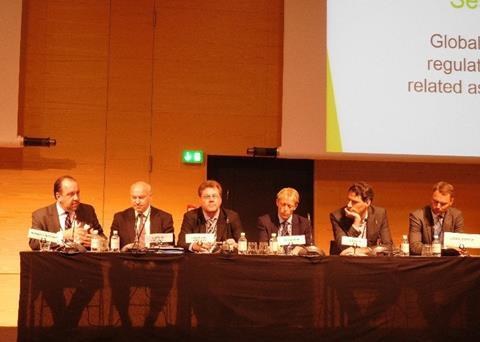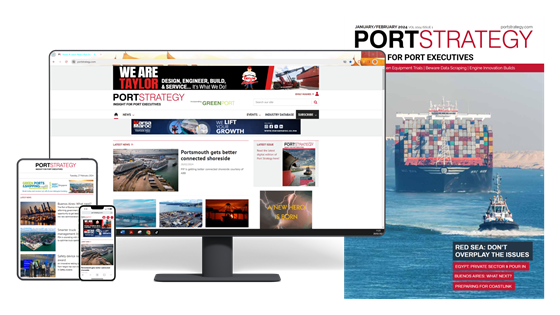For the first time this year GreenPort Live provided instant coverage of the first day of the GreenPort Congress 2015 enabling all those in the industry to share knowledge about putting green practice into place.

Opening the Congress, moderator and GreenPort founder, Patrick Hicks, said: "We are fortunate to be living in a period of extraordinary change, at a time where the port industry is growing rapidly in hand with increasing awareness of social, economic and of course environmental sustainability.”
Johan Röstin, CEO of Copenhagen Malmo Port, host of the congress this year, talked about integration of the port with the European centre of logistics.
On the Malmo side, the port has a 2030 vision, with everything - logistics, loading and pre-clearance - available within 15 minutes. On the Danish side it is investigating how to build a new container terminal. Last year it inaugurated a new three-birth cruise terminal and by 2030 it will have new road infrastructure connecting new port areas to the city - as well as a new metro system.
CMP has looked taken action on water, noise and soil pollution, said Mr Rostin - including a torpedo to clean up oil-polluted water, and it is working with universities to measure the port's impact on the seabed.
“But still making sure that people think 'environment' can be a challenge with some external stakeholders,” he said.
Global vs regional regs
During the first session, Patrick Verhoeven, secretary general of the European Community Shipowners’ Associations (ECSA), introduced a broad session discussing the impact of recently introduced sulphur regulations and what has been learned both by regulators and industry operators.
He noted that there is room for a forum bringing together both ports and shipping companies in this area, but the two sides must face the problems together.
Dimitrios Theologitis, Head of Unit Ports & Inland Navigation, DG Move, talked about the forecasted growth in trade volumes, bigger ships, data-driven technologies and noted some of the many things port operators can do in response.
“Of course global regulation is the best possible way, but all global starts with regional moves. Someone has to make the proposal. And if that someone is part of the EU, the EU must recognise the proposal - the experience of sulphur ECAs shows what happens if there is not regional recognition,” he said.
Edvard Molitor, Senior Manager Environment, Port of Gothenburg, noted that SOx emissions in Gothenburg have dropped by 80% since January, with no traffic problems caused by the SECA - although he said that some containerships are detouring to minimise SECA time.
"A lot of focus was put on trying to remove the SECA decision instead of trying to meet it," said Mr Molitor. "It seems that the industry has learned how to push these issues back - I would encourage the industry to focus rather on meeting regulations.”
On the interplay of global v regional regulation, Olaf Merk, from the International Transport Forum highlighted the need for cooperation first at a local level when regulations such as the sulphur directive are introduced, where ports have an essential 'stage director' role to play.
On a global level, he asserted the need for a regular stakeholder conference not just for green issues, but on all issues affecting the supply chain.
Changing expectations
During session 2, Dr Antonis Michail, senior policy advisor, ESPO, began the session with a presentation on the common challenges facing ports.
"Priorities evolve and not all are relevant to each port," he said. "We cannot say that a green port is one that addresses air quality, for example, if it is not a priority for that port. So we need to take a borader approach."
"A green port is one that has a systematic approach, measures its environmental progress and sets ambitious targets towards continuous improvement," he said.
Rob Winkel of Ecofys explained how the company works with ports on sustainable energy programmes. "By introducing energy management you increase energy efficiency by 2%, for many years, Energy audits are helpful, showing where the biggest energy consumers are - buildings, rolling equipment, heating and so on. Having done this ports can create an energy investment plan."
Working groups
The working groups at the end of the first day covered fuel options for SECA Compliance, port reception facilities and improving efficiency in terminal operations.
In the SECA compliance session, a representative from the port of Bergen asked about the viability of Norway's LNG terminals.
Johanne Solheim, adviser, Norwegian Ports Association, cited strong government support for LNG - including the long-established NOx fund - as contributing to the spread of the fuel.
"It is a challenge because of our geography and topography to provide LNG at a competitive rate, particularly given the price of oil - I think that will be an open question for a few years."
Eero Lehtovaara, senior vice president, BU Marine & Ports, ABB summed up the first day of the conference in a nutshell.
"If we combine ship side and ports and see it as one ecosystem as long as the ship is there, we will see benefits for all sides,” he said. "The technology is all there. How we put together is a different question.”







